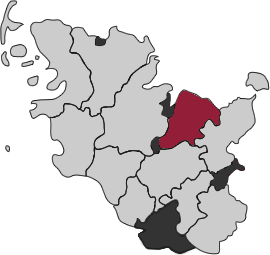Das Freilichtmuseum „Turmhügelburg Lütjenburg“ ist die authentische Rekonstruktion einer mittelalterlichen Siedlung mit der hölzernen Burg eines Niederadeligen, wie sie im 12. bis in das 15. Jahrhundert in Schleswig-Holstein existierten.
Im Zuge der Christianisierung Ostholsteins seit dem 12. Jahrhundert siedelten deutsche Adelige auch in Gebieten der Ostsee und befestigten ihre Wohnsitze mit Turmhügelburgen – in ganz Schleswig-Holstein bestanden dabei über 400 solcher Kleinburgen. Allein in den Kreisen Plön und Ostholstein sind heute in der Landschaft noch Erdbaureste (Hügel) von mindestens 80 Turmhügelburgen erkennbar, die christliche „deutsche“ Ritter zur Zeit der Landnahme/Christianisierung zum Schutze ihres Besitzes erbauten.
Die Besucher betreten die Vorburg durch ein mächtiges Eingangstor, besichtigen den Getreidespeicher, das Wohn-/Stallgebäude des Gesindes, die Schmiede, wandeln vorbei am zentralen Brunnen zum Herrenhaus des Ritters, zu seinem riesigen Wirtschaftsgebäude und im hinteren Bereich zur christlichen Vicelin-Kapelle. Auf den angrenzenden Ländereien stehen die Backhäuser mit den mächtigen Lehmbacköfen und etwas abseits liegt die „Zeidlerei“ zur Honigherstellung.
Die aufragende Fluchtburg, die hölzerne „Turmhügelburg“, erreicht der Besucher durch ein verschließbares Tor und über eine massive Brücke, die über den Burggraben führt. Von der Galerie des Turms im zweiten Stock genießen die Gäste einen herrlichen Blick über das gesamte Burggelände mit Turnierplatz und Reitbahn und die wunderschöne Stauchmoränenlandschaft.
In der Saison wird die weitläufige Anlage regelmäßig von Mittelaltergruppen mit zahlreichen Zelten, Mittelalter-Ständen und Vorführungen belebt; der Besucher wandert durch eine „lebendige Siedlung“ und kann dann besichtigen, wie im Mittelalter in der Burg gelebt, gegessen und gearbeitet wurde. Mittelalterliche Musik- und Veranstaltungsgruppen auf einer Zeltbühne bereichern darüber hinaus das vielfältige Programm und für junge und alte Besucher sind Spielbereiche und Lagerfeuer aufgebaut. Eine längst vergangene Zeit wird wieder lebendig.
Am Burgeingang wird um ein Burgopfer von 2,- € gebeten.
Bei Führungen: Erwachsene 4,- €, Kinder (ab 9 Jahre) 3,- €
Bei Veranstaltungen: Erwachsene 5,- €, Kinder ab 6 Jahren 3,- €
Regelmäßige Führungen
Regelmäßige Führungen:
Mai bis Sept.: Mi und Sa: 15 Uhr und So: 11 Uhr.
Buchungen von Burgführungen auf Anfrage: 0157 354 800 64.
Burgführungen:
Vom 1. Mai bis 30. September ohne Voranmeldung jeweils mittwochs und samstags um 15.00 Uhr und sonntags um 11.00 Uhr.
Treffpunkt vor dem Eingang des Museums. Dauer jeweils ca. 60 - 90 Minuten.
Gruppenführungen mit Voranmeldung:
Erwachsene: 4,- € / Kinder ab 9 Jahren: 3,- €, Kinder bis 8 Jahre: frei. Schulklassen: 3,- € pro Kind.
(Der Eintrittspreis ist in bar zu entrichten. Spendenquittung auf Anfrage.)
Wir bieten an: Führungen in niederdeutscher, englischer oder niederländischer Sprache und spezielle Führungen für Kinder und Jugendliche.
Anfragen an die Museumsleitung (Nils Hinrichsen): 0157 354 800 64.
- Klaus Dygutsch und Jörn Feustel: Turmhügelburg im Nienthal von Lütjenburg (Museumsführer), herausgegeben von der Gesellschaft der Freunde der mittelalterlichen Burg in Lütjenburg e. V., Hamburg o. J.
- Jens Friedhoff: „Lebendiges Mittelalter“ und „vergessene Ruinen“ – die Turmhügelburg Lütjenburg und die Burgruine Glambeck in Schleswig-Holstein, in: Burgen und Schlösser. Zeitschrift für Burgenforschung und Denkmalpflege 53,4 (2012), S. 215 – 221.
- Oliver Auge (Hrsg): Burgen in Schleswig-Holstein. Zeugen des Mittelalters einst und jetzt, Kiel/Hamburg 2019.
- Oliver Auge (Hrsg.): Vergessenes Burgenland Schleswig-Holstein. Die Burgenlandschaft zwischen Elbe und Königsau im Hoch- und Spätmittelalter, Beiträge einer interdisziplinären Tagung in Kiel vom 20. bis 22. September 2013. Kieler Werkstücke, Reihe A: Beiträge zur schleswig-holsteinischen und skandinavischen Geschichte, Frankfurt am Main 2015.
- Hermann Hinz: Motte und Donjon. Zur Frühgeschichte der mittelalterlichen Adelsburg, Köln 1981.
- Arthur Dähn: Ringwälle und Turmhügel: mittelalterliche Burgen in Schleswig-Holstein. Unter Mitarb. von Susan Möller-Wiering, Husum 2001.
Burgbelebungen:
Das ganze Jahr hindurch bereichern diverse Mittelaltergruppen unsere Burganlage und füllen sie mit Leben. Zu den Burgbelebungen sind Besucher herzlich willkommen.
Kapelle:
In der Vicelinkapelle auf der Vorburg finden Gottesdienste und Veranstaltungen mit Minnegesänge statt und steht für (mittelalterliche) Hochzeiten zur Verfügung. (Anfragen bitte an: info@turmhuegelburg.de.)
Tiere:
Hunde dürfen mit auf das Museumsgelände, aber sie möchten an der Leine geführt werden.
Anreise mit dem PKW
Von der A1:
- abfahren Ausfahrt Oldenburg i. H.- Süd
- B202 in Richtung Lütjenburg
- abfahren Lütjenburg-Mitte in die Hindenburg Str.
- nächste links in die Schönberger Str.
- am Kreisel die dritte Ausfahrt Richtung Panker
- erste Straße (Bunendorp) links abbiegen und bis zum Parkplatz
Für Gehbehinderte bitte die zweite Straße links abbiegen
Von der B202 aus Richtung Kiel:
- abfahren Lütjenburg – West
- an der Ampelkreuzung nach links in die Schönberger Str.
- am Kreisel die dritte Ausfahrt Richtung Panker
- erste Straße (Bunendorp) links abbiegen und bis zum Parkplatz
Für Gehbehinderte bitte die zweite Straße (Nienthal) links abbiegen.
Von der L165 aus Richtung Kiel:
- hinter Darry die zweite Straße (Bunendorp) rechts abbiegen und bis zum Parkplatz
Für Gehbehinderte bitte die erste Straße (Nienthal) rechts abbiegen.
Von der B430 aus Richtung Plön:
- von der Plöner Str. nach links die Vorfahrtsstraße folgen auf die Schönberger Str.
- am Kreisel die dritte Ausfahrt Richtung Panker - erste Straße (Bunendorp) links abbiegen und bis zum Parkplatz
Für Gehbehinderte bitte die erste Straße (Nienthal) rechts abbiegen.
Mit Bus:
(Infos unter www.nah.sh)
- aus Richtung Kiel / Oldenburg Haltestelle "Kaserne/Schule"
- über Hochmode in den Fußweg
- nach ca. 400 m sieht man die Burg.
Finden Sie weitere Museen…
vom Typ:
Freilichtmuseum
Regional-/Stadtgeschichte
aus der Region:
Plön
in:
Lütjenburg

